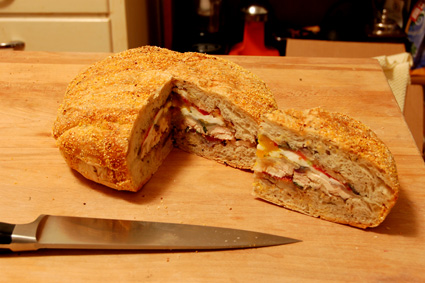Adapting to a new kitchen is always tricky, whether it be cooking dinner at a friend's place or, currently for me, making the adjustments to a new home. Cooking is now complicated by a variety of factors: the sink's in a separate room from the stove and refrigerator1; the only counter space is what we've provided2; and the contents of our pantry are still in boxes until the new shelves are delivered. Tomorrow, assuming all goes well.
On the upside, we've been fortunate in finding good, fresh, local food. The growers' market, which takes place on Friday afternoons, is fairly small, so the result is that the vegetables have pretty much been harvested that morning. Our new potatoes were dug the night before, and the farmer actually apologized for it. As though we were capable of discerning the difference.
So, what to do with all that fresh food? Since good bread's tougher to come by, and I've been making the no-knead recipe pretty regularly, it's seemed like a good time for sandwiches. Nice, keep-the-apartment-cool-style sandwiches. A boule, though, doesn't make for great sandwich slices, not like one done in a loaf pan. And I haven't rigged up a loaf pan enclosure for that wonderfully crispy crust just yet.
Plus, summer's a great time to fire up the grill. We'd gotten an unusual chicken - I forget the breed name - at the market, one with massive legs and, as a result, loads of dark meat. Grill plus chicken tends to mean barbecued chicken, even if a whole bird's more than the two of us could possibly eat at once.
So? I looked in one of my new books, Mark Bittman's How To Cook Everything, which is essentially a different take on the same ground that Joy covers. With Bittman's usual minimalist twist, of course. Good, simple ideas; easily adaptable. The result?

Pan bagna, or bathed bread. It's a monstrous sandwich, enough to feed four, or six with a couple of hearty side dishes. Since I already had the coals going for the barbecued chicken, I took advantage and tossed on the chicken breasts and some eggplant, as well. The whole process takes a long time - overnight, at least - but without much active cooking. The day of, you've got an easily-sliced, readily-transportable, pre-made and heat-free meal. A side salad, pickles and chips, and you're all set.
Suffice to say, the following recipe's just a very basic guideline. What follows is what I made, given what I had lying about; every subsequent sandwich is going to be unique.
* * * * *
Pan Bagna
Serves four
IngredientsDirections
- One 1½ lb. boule loaf
- Two chicken breasts, grilled, with salt and pepper
- One medium eggplant, in ¼-inch slices, salted and grilled
- One large tomato, thinly sliced
- Two small onions, slowly caramelized in butter
- Three hard-boiled eggs, thinly sliced
- A handful of fresh mint leaves
- Parmesan cheese, freshly grated
- Salt and pepper to taste
- Slice the bread horizontally - as if it were a giant hamburger bun - and open it up. Pull out approximately half of the crumb, trying to leave an even layer all around.
- Fill the cavity with layers of ingredients. Since you'll eventually be slicing it like a cake, arranging layers of varying colors looks best. Pile it high, and set the top of the loaf back on.
- Wrap the sandwich tightly in foil. Set on a plate, with another plate on top, upside down, and weigh it all down. The more weight, the better; boxes of salt or large cans work well. Place in the refrigerator overnight.
- To serve, unwrap from the foil and slice in quarters (or sixths). The overnight pressing will have allowed the bread to soak up all of the meat and vegetable juices, while compacting it all into a stable sandwich that can be eaten with one hand.
It's possible to slice it into eighths, as well, though it's tougher to keep it all together as the wedges get smaller; I wouldn't try for anything less than that. Alternately, you could reheat the entire sandwich - still in foil - in a 300F oven for fifteen or twenty minutes before slicing.
1It seems as though the house was originally built without indoor plumbing; a subsequent small bumpout on the side houses everything that needs water.
2So, in other words, it's minimal. We're working on it, but for now cooking takes a significant amount of planning for anything but the simplest meals.

No comments:
Post a Comment